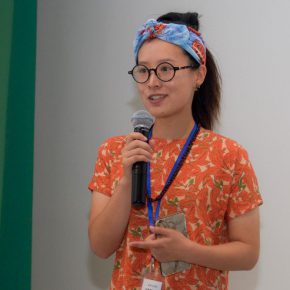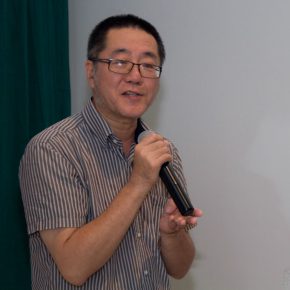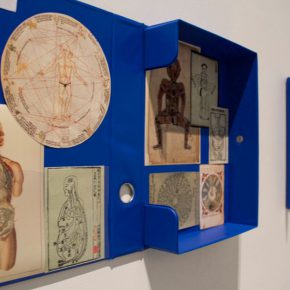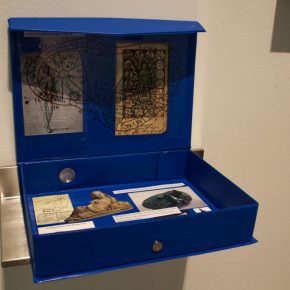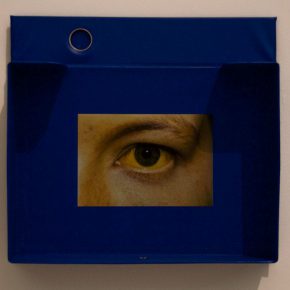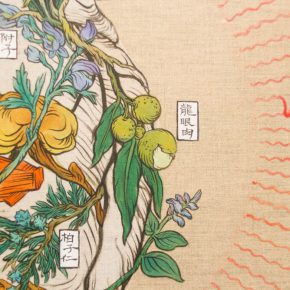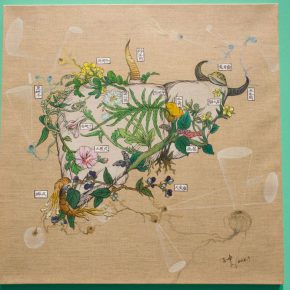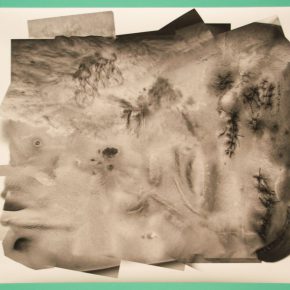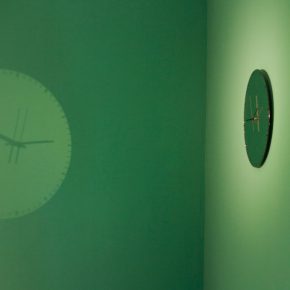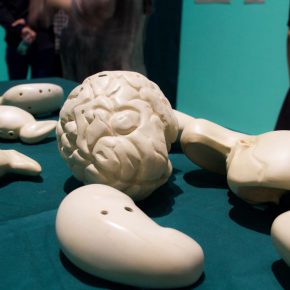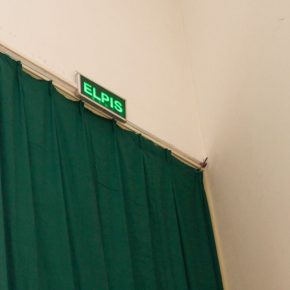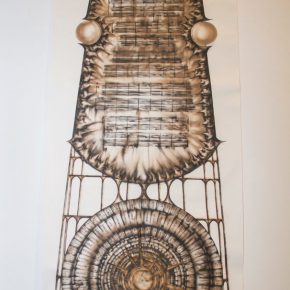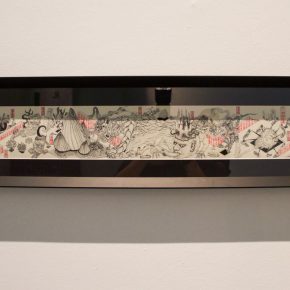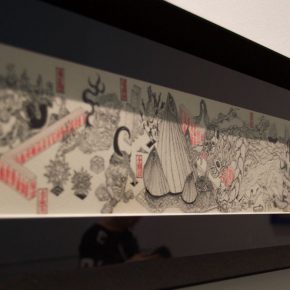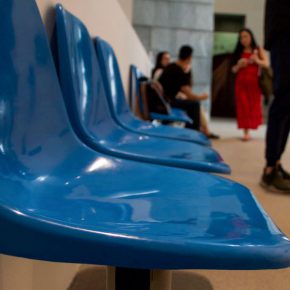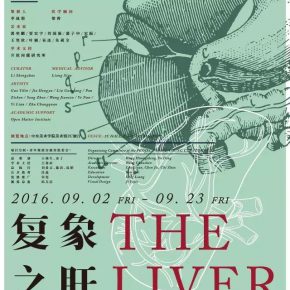
“In the early languages of ancient Babylon, Arabic, the liver was considered as a significant organ that stores the blood, considered equivalent to life itself, containing the soul, emotions and intelligence.” On September 2, 2016, the young curator Li Shengzhao started from the “liver”, together with 9 artists including Guo Yilin, Zhu Changquan, Pan Zishen, Wang Jianxin, Yi Lian, Song Zhen, Liu Guoqiang, Ye Nan, Jia Hongyu, to unveil the exhibition of “The Liver” at 2C Hall, CAFA Art Museum.
The exhibition venue is deliberately divided into 2 parts with a green curtain by the curator Li Shengzhao, above the door is the symbol “ELPIS”, which stands for “hope”. “Only hope holds solid residence”, the immortal liver is like the neutral hope (elpis) which is the last thing remaining in Pandora’s box, as the story goes and it is hidden in our bodies.
The exterior exhibition space is decorated as a clinic, showcasing works which are often related to hope and waiting: in the entrance it places a liver-colored installation made of stone; which can be traced back to the mysterious ritual that used the liver for divination in ancient Egyptian times; the magnificent monuments left by the talented artists who died of liver diseases… the curator cleverly placed the documents regarding liver in the folder of the hospital, alternately presenting them in the exhibition hall. In the exterior space, a green curtain opens to a field themed “renovation”, while in the center of the hall it places an operating table painted green together with the walls. On the table, it places human-liver-shaped ceramic instruments entitled Xun as created by the artist, while each organ can play music; in addition, the view can enjoy the oil painting entitled “Watchmen Alliance” which depicts taking herbs as the guard against illness; aimed at the restoration of time, the installation of a video backs up time; “repairing the visual” impression formed by the scars of countless people; dominated by a recording, it is a smart fantasy design that resonates with the illness caused by “liver quiver”…
In the opinion of the curator Li Shengzhao, no matter whether it is a “mirror” image related to wisdom and intelligence, or the image of “hope” related to regeneration or renovation, the “liver” from myths and traditions is intersected with the understanding and demonstration of “liver” in modern medicine. The seemingly mysterious theories do have a real dimension, and they mutually weave a huge and complex network for civilization. For the understanding of the theme of “The Liver”, Li Shengzhao said that the exhibition attempted to integrate the existing text which was previously researched with the present medical explanation, and artists’ imaging of the liver, how to make the liver a tool for imaging what to image? How does the mirror reflect the self? What does the neutral hope mean? These pixels about the “liver” cross and develop the “reimaging” of “liver” – restoration, repairing, duplication, recovery, complex; Antonin Artaud said: “Reimaging is a kind of self-creation, a non-arrival or aimless endless construction of subjectivity.”
CAFA Art Museum “Project Space – Young Curators’ Lab” project was co-sponsored by the CAFA Art Museum and Young Curator Special Fund at Wu Zuoren International Art Foundation, it invited 6 young curators / teams to plan, implement and display 6 cross-border experimental exhibitions of different dimensions in the platform of “Project Space”. This exhibition is the 2nd session of the project and it remains on view until September 23.
Text by Lin Jiabin, Photo by Hu Sichen/CAFA ART INFO
Translated by Chen Peihua and edited by Sue/CAFA ART INFO
About the Curator:
Li Shengzhao is an independent curator, a researcher of the “Open Matter Institute”. Li graduated from the Contemporary Art and Social Thought Institute at SIMA, China Academy of Art, with a master’s degree. She has shown a long term commitment to the double promotion of curating and theoretical research, her work runs through curating, creation, theoretical research and writing. Li’s present research focuses on the possibility of the practices of daily life about “anti-establishment” and everyday life. She now lives and works in Hangzhou.
About Medical Advisor:
Liang Xiao, Hepato-pancreato-biliary physician at Sir Run Run Shaw Hospital affiliated to Zhejiang University School of Medicine, associate professor, master tutor, Doctor of Medicine.
About the Artists:
Born in Shanxi in 1985, Guo Yilin currently is in cooperation with Sir Run Run Shaw Hospital affiliated to Zhejiang University School of Medicine to shoot documentary films. He lives and works in Hangzhou.
Jia Hongyu was born in the 1980s, now living and working in Beijing. Jia’s inspired by lasting impressions while walking on the streets and observing, focusing on the changes of landscape in the fickle time and the evanescence of halo. Jia has a particular research and interest in substances and materials.
Liu Guoqiang was born in Shandong in 1988.
Born in the 1980s, Pan Zishen is a compound artist. Pan is committed to breaking through the thought process between medicine and art, taking life as a medicinal usher, art can be used as medicine, trying to resolve the so-called daily routine, so that people will not be afraid to look forward to the distant shore and the huge hole between shores, carrying out the treatment out.
Song Zhen was born in Zhangjiakou, Hebei in 1983, currently teaching at the Total Art Studio of SIMA, China Academy of Art.
Wang Jianxin through interviews creates things, a drawer which makes a living by drawing strange images. Wang searches daily for a variety of extinct data in the network and ancient book shops. He studies various painting techniques in comics.
Born in 1984, Ye Nan currently lives and works in Beijing and Hangzhou.
Yi Lian was born in Jiangxi Province in 1987, graduated from SIMA, China Academy of Art in 2012 and received a master’s degree.
Born in Shandong in 1989, Zhu Changquan started from the analysis of daily life to intervene in art events. Zhu thinks the development of things is definitely not a single line, and “all factors have narrative” this is the understanding of imaging creation by the artist.


